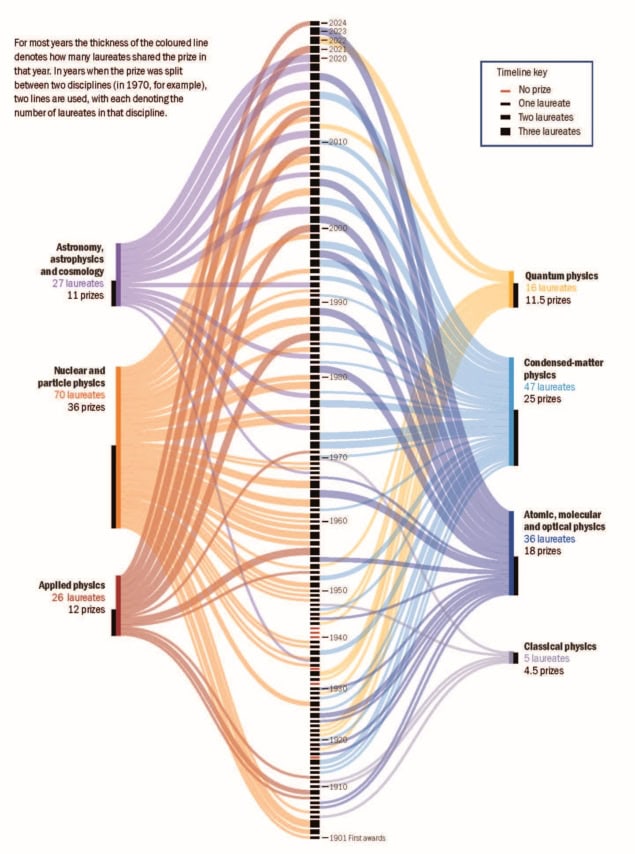
On Tuesday, 7 October, the winner(s) of the 2025 Nobel Prize for Physics will be announced. The process of choosing the winners is highly secretive, so looking for hints about who will be this year’s laureates is futitle. Indeed, in the immediate run-up to announcement, only members of the Nobel Committee for Physics and the Class for Physics at the Royal Swedish Academy of Sciences know who will be minted as the latest Nobel laureates. What is more, recent prizes provide little guidance because the deliberations and nominations are kept secret for 50 years. So, we really are in the dark when it comes to predicting who will be named next week.
If you would like to learn more about how the Nobel Prize for Physics is awarded, check out this profile of Lars Brink, who served on the Nobel Committee for Physics on eight occasions.
But this level of secrecy doesn’t stop people like me from speculating about this year’s winners. Before I explain the rather lovely infographic that illustrates this article – and how it could be used to predict future Nobel winners – I am going to share my first prediction for next week.
Inspired by last year’s physics Nobel prize, which went to two computer scientists for their work on artificial intelligence, I am predicting that the 2025 laureates will be honoured for their work on quantum information and algorithms. Much of the pioneering work in this field was done several decades ago, and has come to fruition in functioning quantum computers and cryptography systems. So the time seems right for an award and I have four people in mind. They are Peter Shor, Gilles Brassard, Charles Bennett and David Deutsch. However, only three can share the prize.
Moving on to our infographic, which gives a bit of pseudoscientific credibility to my next predictions! It charts the history of the physics Nobel prize in terms of field of endeavour. One thing that is apparent from the infographic is that since about 1990 there have been clear gaps between awards in certain fields. If you look at “atomic, molecular and optical physics”, for example, there are gaps between awards of about 5–10 years. One might conclude, therefore, that the Nobel committee considers the field of an award and tries to avoid bunching together awards in the same field.
Looking at the infographic, it looks like we are long overdue a prize in nuclear and particle physics – the last being ten years ago. However, we haven’t had many big breakthroughs in this field lately. Two aspects of particle physics that have been very fruitful in the 21st century have been the study of the quark–gluon plasma formed when heavy nuclei collide; and the precise study of antimatter – observing how it behaves under gravity, for example. But I think it might be a bit too early for Nobels in these fields.
One possibility for a particle-physics Nobel is the development of the theory of cosmic inflation, which seeks to explain the observed nature of the current universe by invoking an exponential expansion of the universe in its very early history. If an award were given for inflation, it would most certainly go to Alan Guth and Andrei Linde. A natural for the third slot would have been Alexei Starobinsky, who sadly died in 2023 – and Nobel’s are not awarded posthumously. If there was a third winner for inflation, it would probably be Paul Steinhardt.
Invisibility cloaks
2016 was the last year that we have had a Nobel prize in condensed matter physics, so what work in that field would be worthy of an award this year? There has been a lot of very interesting research done in the field of metamaterials – materials that are engineered to have specific properties, particularly in terms of how they interact with light or sound. A Nobel prize for metamaterials would surely go to the theorist John Pendry, who pioneered the concept of transformation optics. This simplifies our understanding of how light interacts with metamaterials and helps with the design of objects and devices with amazing properties. These include invisibility cloaks –the first of which was built in 2006 by the experimentalist David Smith, who I think is also a contender for this year’s Nobel prize. Smith’s cloak works at microwave frequencies, but my nomination for the third slot has done an amazing amount of work on developing metamaterials for practical applications in optics. If you follow this field, you know that I am thinking of the applied physicist Federico Capasso – who is also known for the invention of the quantum cascade laser.
The post Quantum information or metamaterials: our predictions for this year’s Nobel Prize for Physics appeared first on Physics World.

